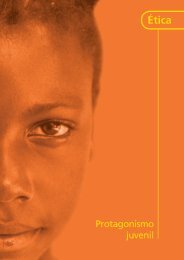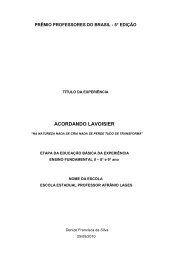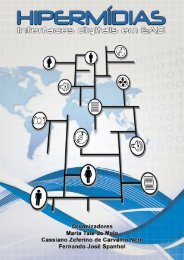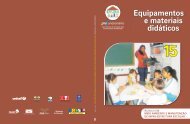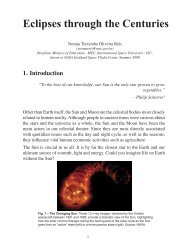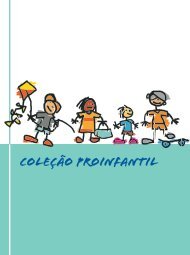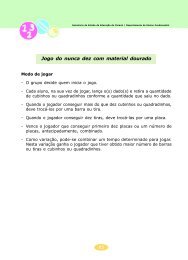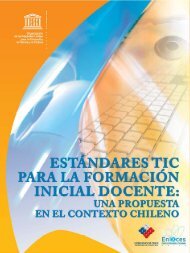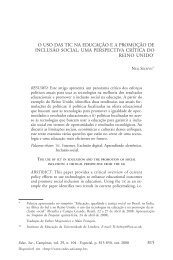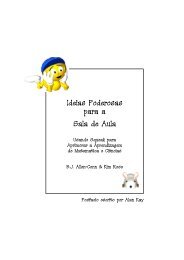BIO-CULTURAL COMMUNITY PROTOCOLS - Portal do Professor
BIO-CULTURAL COMMUNITY PROTOCOLS - Portal do Professor
BIO-CULTURAL COMMUNITY PROTOCOLS - Portal do Professor
Create successful ePaper yourself
Turn your PDF publications into a flip-book with our unique Google optimized e-Paper software.
PART I / CHAPTER 2<br />
3.6 The Cultural Importance of TK<br />
and Indigenous Breeds<br />
All communities greatly emphasized the cultural importance<br />
of their TK and where applicable, their indigenous breeds. The<br />
Bushbuckridge traditional healers, for example, explained how<br />
they perform a number of important roles as traditional healers<br />
that underpin their Sepedi or Tsonga cultures:<br />
As well as treating conventional illnesses, we perform a number<br />
of other culturally significant roles in the community. We<br />
connect community members to their ancestors in different<br />
ways, including assisting families when their newborn babies<br />
cry for their names, carrying out coming of age ceremonies,<br />
providing counseling for a range of issues, chasing away evil<br />
spirits through cleansing ceremonies, and determining when<br />
the ancestors are calling someone to become a traditional healer.<br />
We also induct new traditional healers, providing initiation<br />
and training, thus passing on our knowledge and culture to<br />
future generations. All of the above contributes to healthy<br />
communities, builds leadership and morale, and promotes<br />
our culture. 15<br />
Likewise, the Samburu set out a number of areas of their<br />
culture in which their breeds are important. They state:<br />
In addition to the sustenance our livestock provides us, they<br />
also play a significant role in our culture. A number of examples<br />
illustrate this point:<br />
• Each clan’s elders decide on the age set for initiating boys,<br />
and a bull is slaughtered to validate that age set;<br />
• During the coming of age ceremony, boys are circumcised<br />
while wearing and sitting on Red Maasai sheep skins;<br />
• As part of wedding ceremonies, the man must find a pure<br />
Red Maasai sheep (signified by its red color, long ears and<br />
clear eyes) and present it to his future Mother-in-Law who<br />
is then referred to as “Paker”, literally meaning “the one who<br />
has been given sheep.” Another sheep is slaughtered<br />
for the wedding;<br />
• The bride is given a calabash full of milk and a gourd<br />
that is filled with the fat of from the tail of the Red Maasai<br />
sheep, drinking the milk to assuage her fears about going<br />
15. Supra note 8.<br />
16. Supra note 2.<br />
<strong>BIO</strong>-<strong>CULTURAL</strong> <strong>COMMUNITY</strong> <strong>PROTOCOLS</strong> AS A<br />
<strong>COMMUNITY</strong>-BASED RESPONSE TO THE CBD<br />
to the new home and moisturizing her skin with the fat<br />
to relax her;<br />
• When a child is born, a sheep is slaughtered, and when<br />
someone dies, sheep fat is smeared on their mouths<br />
as a sign of respect; and<br />
• When we slaughter for warriors, we choose only one<br />
color which they say is straight, also when someone is sick,<br />
then they slaughter an animal that is healthy, with all the<br />
teeth and eyes. There is a special steer (castrated bull) that<br />
is slaughtered and a part of the skin is used as a ring.<br />
The color has to be accepted by the community and it<br />
must have all its teeth intact.<br />
Notably, whilst mixed breeds can be used in lean times, the<br />
pure indigenous breeds are more highly valued for use in<br />
our ceremonies. 16<br />
They concluded by saying: “Our culture and animal breeds<br />
are integral to who we are as a People. Without our<br />
indigenous breeds we will lose a critical part of our<br />
collective bio-cultural heritage, and without our culture our<br />
indigenous breeds are less likely to be conserved.”<br />
3.7 Traditional Knowledge, Sharing and<br />
Free, Prior and Informed Consent<br />
In continuation of the last point, the idea of ABS and its<br />
constituent parts such as FPIC is novel to many communities.<br />
Communities need time to think through what prior<br />
informed consent to use their natural resources or TK really<br />
entails, especially when the idea of owning or selling<br />
resources or knowledge can be alien.<br />
Natural Justice’s approach has been to work with<br />
communities to think through the customary laws that relate<br />
to the sharing of TK and use of natural resources, helping<br />
communities to extend the values that underpin their TK<br />
or access to resources to other new stakeholders such<br />
as (non-) commercial researchers.<br />
All the groups mentioned above discussed how they<br />
came to know their knowledge and how they share it<br />
with each other. In fact, the sharing of knowledge was<br />
presented by all groups as one of the most important<br />
28




